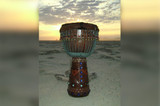Learning the Djembe, Conga and Doumbek
With the holiday season in full swing, maybe you are one of the lucky people who received a drum wrapped in brightly colored paper and tied with a sparkly bow. Drums are the perfect gift for the person who has everything, a musically-oriented healer, or a percussion buff who wants to add new sound to their repertoire. Playing a new drum, regardless of your experience level, can be challenging (yet, rewarding!), and it always helps to have a “quick start” guide to what will become your latest hobby.
To play your new Djembe, keep in mind that your posture is just as important as the rhythms you play. Poor posture can take away from your enjoyment, and may even affect your ability to play rhythms and tempos you enjoy. Be sure that you sit up straight and do not slouch over your drum. Choose a chair, stool or other surface that is best for your height. Rest your hands flat on the head of the drum, being sure to keep your arms straight between your elbows and fingertips. If you stand, invest in a strap that goes over one shoulder and across your chest, or one you can wrap around your waist, keeping the drum at the same distance to your arms and hands, as you would while sitting. When playing your Djembe, be sure to rotate your hands in a “roll” to make the bass, tone or slap sounds, keeping to a simple rhythm until you are more familiar with the sounds, your hand positions and the strength of the hits you make.
Conga drums are made of three different drums that produce their own sounds. The quinto produces the highest pitch followed by the conga and the lowest tones from the tumbadora. A conga drum stand is highly recommended if you have the entire set of three drums. If you only have one drum, it can be played much like the Djembe, resting on the floor between your knees. Conga drums produce five different sounds: muffled stroke, open slap, closed slap, bass tone and open tone, each produced by different hand movements and positions on the drums. To start playing your congas, pop in your favorite salsa or rumba music and try to match the different beats and sounds. Be sure to take advantage of the free online tutorials and instructions, purchase a DVD or join a conga class to further enhance your drumming skills.
The Doumbek, a Middle Eastern, goblet-shaped drum, is typically played while sitting on the floor. The drum is held in the lap, over one thigh, with the head pointing away from the player. The doumbek produces three sounds: “doum,” “tek” and “ka.” The “doum” sound is produced from hitting the center of the drum head with your dominant hand, while the “tek” is played closer to the rim of the drum, using the tips of your fingers. “Ka” is the sound that your other hand makes when striking the drum with the fingers close to the rim, much like the “tek” sound. The most basic rhythm for the Doumbek sounds like “doum doum tek-a-tek doum tek-a-tek,” using each of those different sounds in rapid succession.
Owning your first drum, or even a new drum, is an exciting time for any percussion player, experienced or not. The time spent learning to play the drum can be a great investment in your own creativity and self-expression and can even provide tremendous stress-relieving benefits. Enjoy your drum, and happy holidays!
Recent Posts
-
What is the Best Size Djembe for Beginners?
If you're new to the world of percussion and interested in learning the djembe, you're in for a t …16th Jul 2024 -
The Benefits of Becoming a Drumming Teacher: Transforming Passion into Profession
Why become a drumming teacher? Becoming a drumming teacher is an excellent way to share your pas …22nd May 2024 -
What Makes the Djembe Drum a Spiritual Instrument in African Music?
Origin and history of the Djembe drum The Djembe drum originates from West Africa and holds sign …16th May 2024



